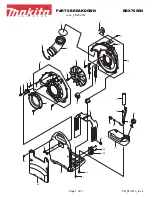
Commissioning
Halyard Swivel Height • Halyard Lead Angle • Halyard Tension
March 1999
Unit 0 MKIII
30
■
Pendants
If your sail is not long enough to position the halyard swivel properly, you must add a pendant to the sail. Pendants
should be plastic coated wire permanently attached to the sail so that whenever the sail is raised the height will be
correct. Adjustable length pendants are not acceptable as they may not be adjusted correctly during a sail change.
Tip: Pendants are most properly used at the head of the sail. Short pendants may be added at the tack when
necessary to improve visibility under the genoa but remember that visibility is already improved by position-
ing the tack of the sail on the furling drum. Tack pendants increase heeling moment by raising the sail plan.
You may install pendants at both the head and tack of the sail, if desired.
■
Halyard Restrainer
To prevent wraps, the jib halyard must pull slightly to the rear. On most boats, the hal-
yard lead angle is acceptable if the halyard swivel is raised to the top of the foil.
On some boats the halyard sheaves are located too close to the headstay and a halyard
restrainer must be used.
Halyard restrainers should be used only when they are required by the masthead
geometry. Restrainers tend to limit sail luff length and may cause problems if not
properly installed.
If your boat needs a halyard restrainer, use Harken part 944.
The restrainer should be mounted as high as possible on the face of the mast. Position
the restrainer so that the foils will not hit it when under load.
The restrainer should deflect the halyard as little as possible or you may experience
difficulty in tensioning the sail luff, friction in furling, and possible damage to the foils.
To decrease deflection angles, shorten the luff of the sail.
Tip: Boats which are used in charter service should consider use of a halyard restrainer, regardless of mast-
head geometry.
■
Halyard Tension
The jib halyard should be firm, but not too tight.
Tip: The luff foil system supports the sail along its entire length so halyard tension is required only to shape
sails, not to support them. Use only enough halyard tension to remove some of the wrinkles along the luff of
the sail. Do not tension the halyard enough to cause vertical wrinkles in the luff of the sail. Use halyard ten-
sion to adjust the position of the draft of the sail to suit the conditions in which you are sailing. Your halyard
should be firm but not tight. If in doubt release halyard tension. To protect the sail, ease the halyard when
the boat is not in use.
■
To Install a Pendant
1) Raise the sail, but do not attach to tack shackle.
2) Position the halyard swivel correctly near the top of the headstay and secure
the halyard.
3) Secure a piece of rope to the tack of the sail. Lead the line through the tack
shackle on the furling drum and tension the sail.
4) Measure the distance from the tack shackle to the tack of the sail and have a
pendant of this length permanently attached to the head of the sail.
5) Repeat this procedure for every jib.
















































